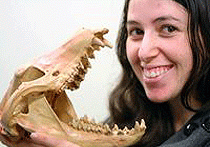Tassie Tiger not guilty
The Tasmanian tiger was hunted to death for allegedly killing sheep, but in fact it had such weak jaws that its prey was probably as small as a possum, a new UNSW study has found.
The Tasmanian tiger was hunted to death for allegedly killing sheep, but in fact it had such weak jaws that its prey was probably as small as a possum, a new UNSW study has found.

Australia's iconic thylacine - or Tasmanian tiger - was hunted to death for allegedly killing sheep, but in fact it had such weak jaws that its prey was probably as small as a possum, a new study has found.
"Our research has shown that its rather feeble jaw restricted it to catching smaller, more agile prey," says ecologist and doctoral student Marie Attard, of the UNSW Computational Biomechanics Research Group, the lead author of a new paper in the Journal of Zoology.
"That's an unusual trait for a large predator like that, considering its substantial 30 kg body mass and carnivorous diet. As for its supposed ability to take prey as large as sheep, our findings suggest that its reputation was at best overblown.
"While there is still much debate about its diet and feeding behaviour, this new insight suggests that its inability to kill large prey may have hastened it on the road to extinction."
"By comparing the skull performance of the extinct thylacine with those of closely related, living species we can predict the likely body size of its prey," says the Director of the Computational Biomechanics Research Group, Dr Stephen Wroe.
"We can be pretty sure that thylacines were competing with other marsupial carnivores to prey on smaller mammals, such as bandicoots, wallabies and possums."
Read the full story at the Faculty of Science newsroom.
Media contacts: UNSW Faculty of Science media liaison - Bob Beale, 0411 705 435